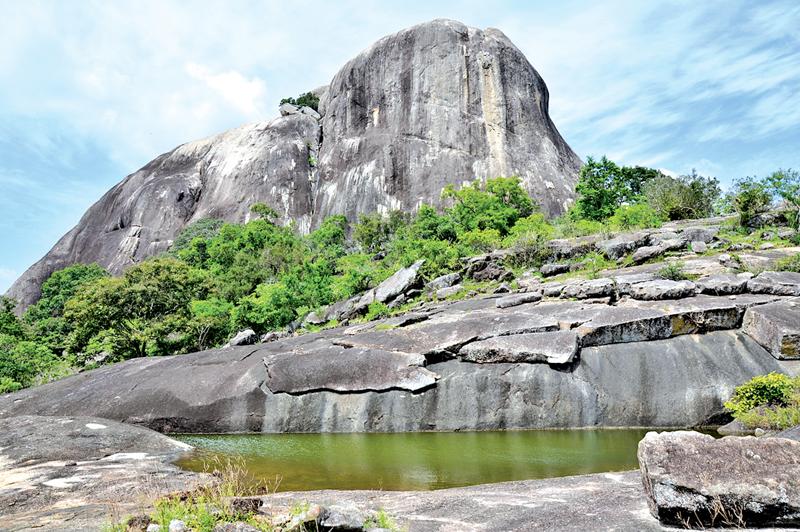
Digital cameras have made my job easier – no more carrying lots of photographic equipment and hundreds of delicate rolls of films to remote locations. Now, hundreds of frames can be recorded to just one digital device and saved in my computer. The Covid-19 curfew enabled me to spend time in my home managing and sorting out folders of unpublished images of my past journeys.
For years, the Kumana bird sanctuary remained a no-man’s land, occupied by LTTE terrorists. It had become a safe haven for poachers, treasure hunters and LTTE activities. Thankfully, now no one needs to fear to travel there.
My routine trip to the Kumana bird sanctuary to enjoy not only the fauna and flora but also to visit the ancient ruins and artefacts led to a tragic discovery. I visited Kumana for the first time in 2013 with a few friends and this was followed by a second visit in 2016. We drove to Okanda from Colombo and trekked along jeep tracks on our way inside the park, stayed at the Galamuna Camp site near the Kumbukkan Oya for a night.
Nearly eight kilometres west of Okanda, the main entrance of the Yala East National Reserve, is the great rocky outcrop of Bambaragasthalawa which was my final destination. The main rock ends in an un-scalable peak, over hundreds of metres high. Spread out in all directions, are immense boulders with water pools, lying singly and in groups. Many of these boulders with drip-ledge caves provided natural shelter and several of them were occupied by generations of monastic bhikkus during the 2nd and 1st centuries BC before the thick jungle engulfed the once prosperous human settlement.
But, today, these rock caves are home to sloth bears and are considered to be one of the difficult rocky terrains to explore and see wildlife.
Historical records provide details about how from these early beginnings, Bambaragasthalawa prospered and grew into an important shrine.
It reached its peak many centuries later during the late Anuradhapura period, when a serene and beautiful recumbent statue of the Buddha was constructed in one of the larger caves.
I saw numerous rock caves with inscriptions and ruined structures in the rocky boulders in the vicinity of Bambaragasthalawa.
All these ancient structures had been damaged by treasure hunters and are in ruins today. Archaeologists believe that in ancient times, the place would have been called Naga Pabbatha Vihara.
Today, it is known as Bambaragasthalawa because of the huge trees found around rocky boulders with Bambara (giant bee) hives, hanging on trees everywhere. From atop the rock, I could see a fascinating sight of a large number of rocky boulders standing out from the forest canopy of Kumana.
It was vandalism of the worst kind on a rare and precious Buddha statue that I stumbled upon in one of the many rock caves scattered around Bambaragasthalawa in Kumana.
When I saw it on my first visit, the head lay smashed to bits and the stomach was dug out in this beautifully -sculptured 24-foot statue, probably dating back to the 9th century AD and crafted in the Anuradhapura tradition.
On my second visit, I saw it was partly renovated by the officers of the Department of Archaeology with the collaboration of the Department of Wildlife. The vicissitudes of time has left most of them in ruins. But it is a pity that humans are also destroying these priceless monuments of our bygone era.
It looked as if the vandals were searching for gems and couldn’t care less whether they were destroying a rare statue. There is a common belief that precious stones and things of value may have been embedded in statues. I found the statue in a pathetic state on my first visit.
Very few such statues made of bricks and sand and lime plaster exist. Usually, statues are cut out of crystalline, lime stone or granite. However, this statue is rare as the folds of the robe and the curls or waves of the hair can be picked out even in the destroyed head and are proof of this along with the size and texture of the bricks used.
The sellipi (rock inscriptions) are on the drip-ledged rock-cave face above the statue. These inscriptions fall into the category of those done in the 2nd or 1st century BC and detail that the rock-caves had been donated to monastic bhikkhus who inhabited them.
Even today, Kumana remains a lost civilisation in a hidden world. Its monuments lie scattered all over the jungle, overgrown and long forgotten. They are visible only in glimpses and fragments, a ruined chaithya atop rock boulders, a crumbling wall in the middle of the jungle.
Wander off the beaten track and you find statues buried in the scrub. It is all a part of a buried history which is still waiting to be unravelled. As I approached a ruined temple complex built on top of the rock, the sunlight at dusk turned the mountain of rocky boulders into a colour palette of beige and orange. When I stood among the ruins on a rocky ridge, I found that the sun had set aflame the trough formed by the flat rock. I tried capturing it on my camera but it was too grand a spectacle for a digital device to do justice to it.
However, the villagers at Panama say that during the conflict the LTTE fighters did not damage any of the artefacts. However, Sri Lankans should be made aware of their national heritage and the importance of preserving it for posterity. The mountainous landscape of shattered rocks in Kumana was spectacular, more so because it was so peaceful. And peace is always beautiful.

